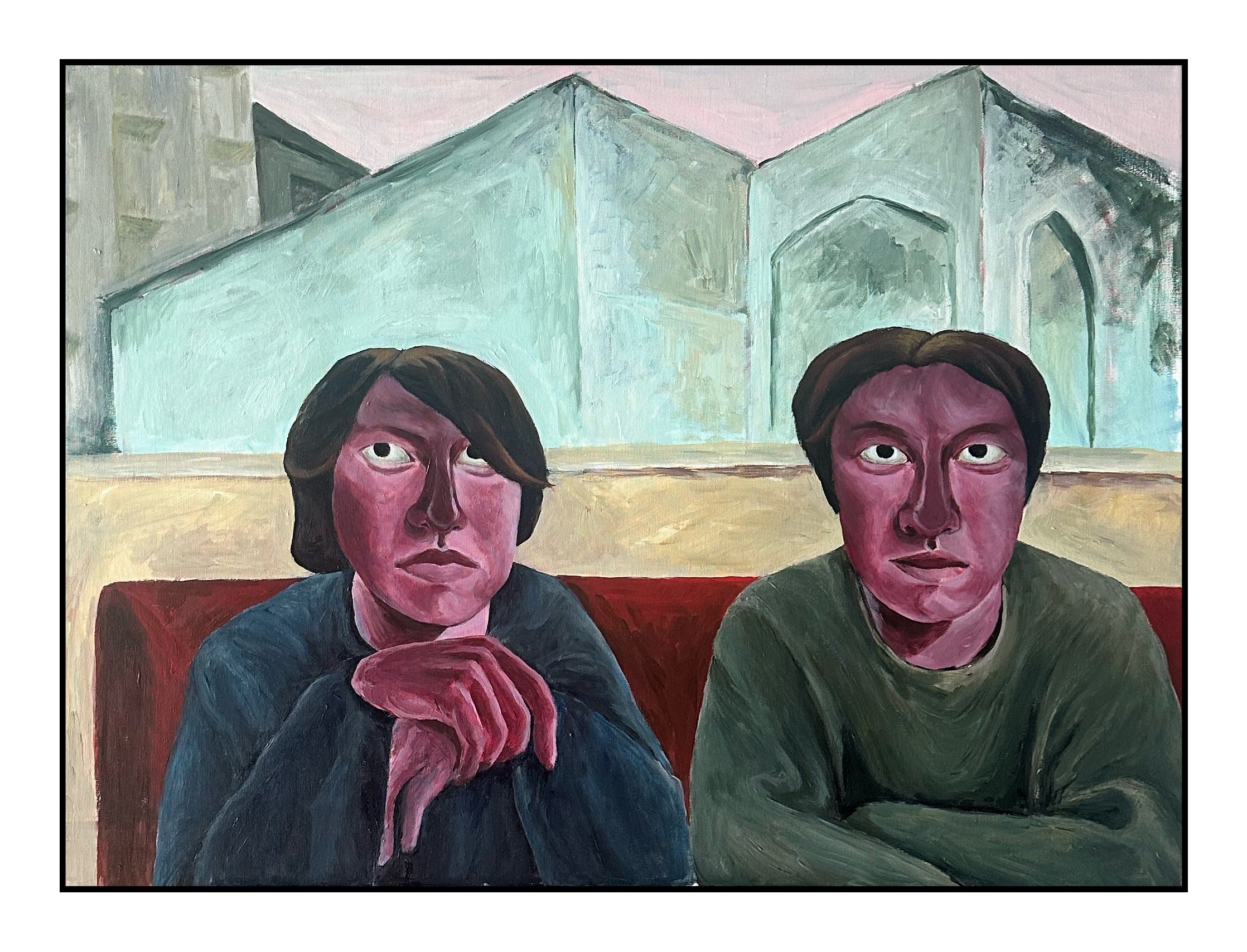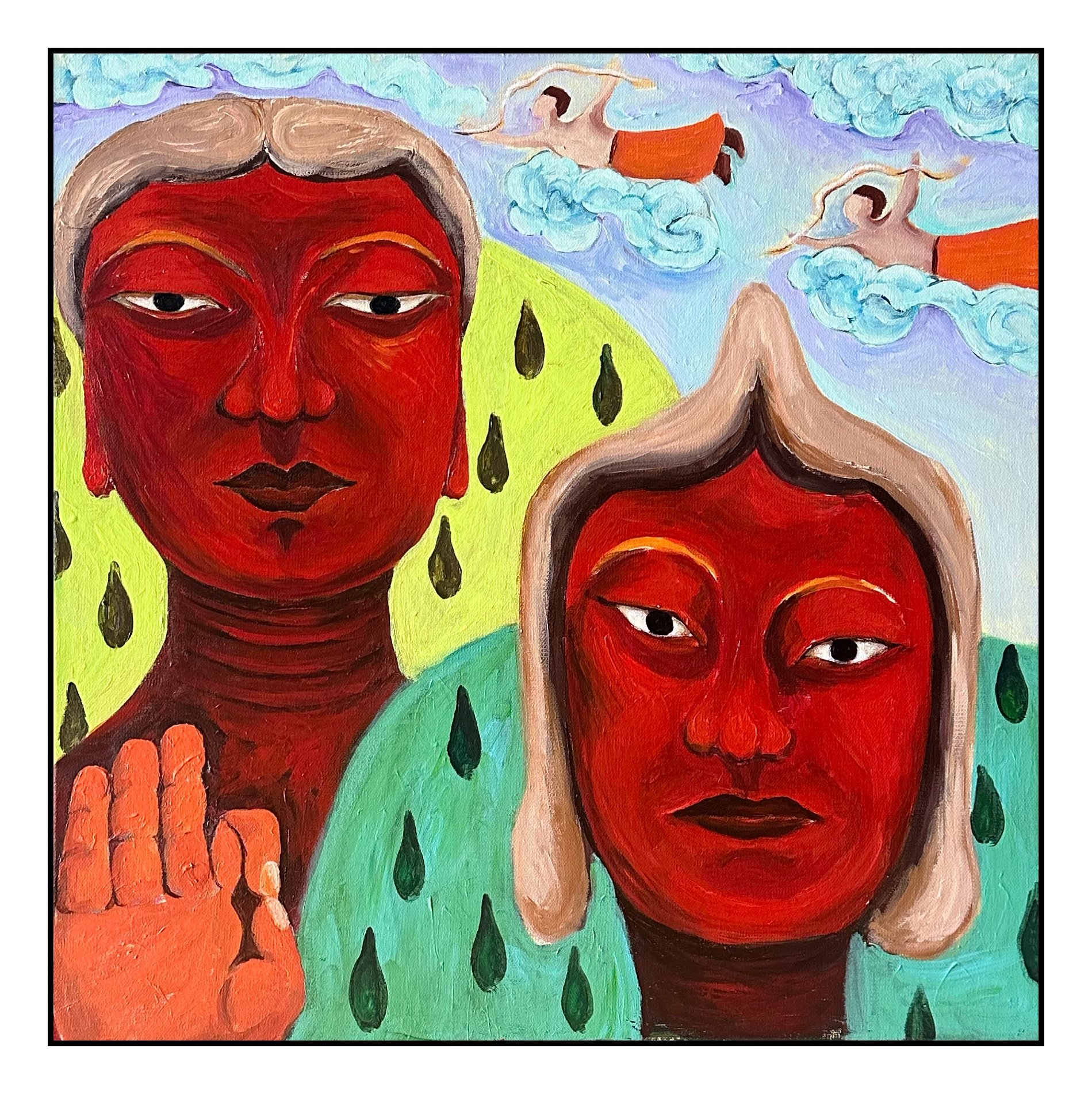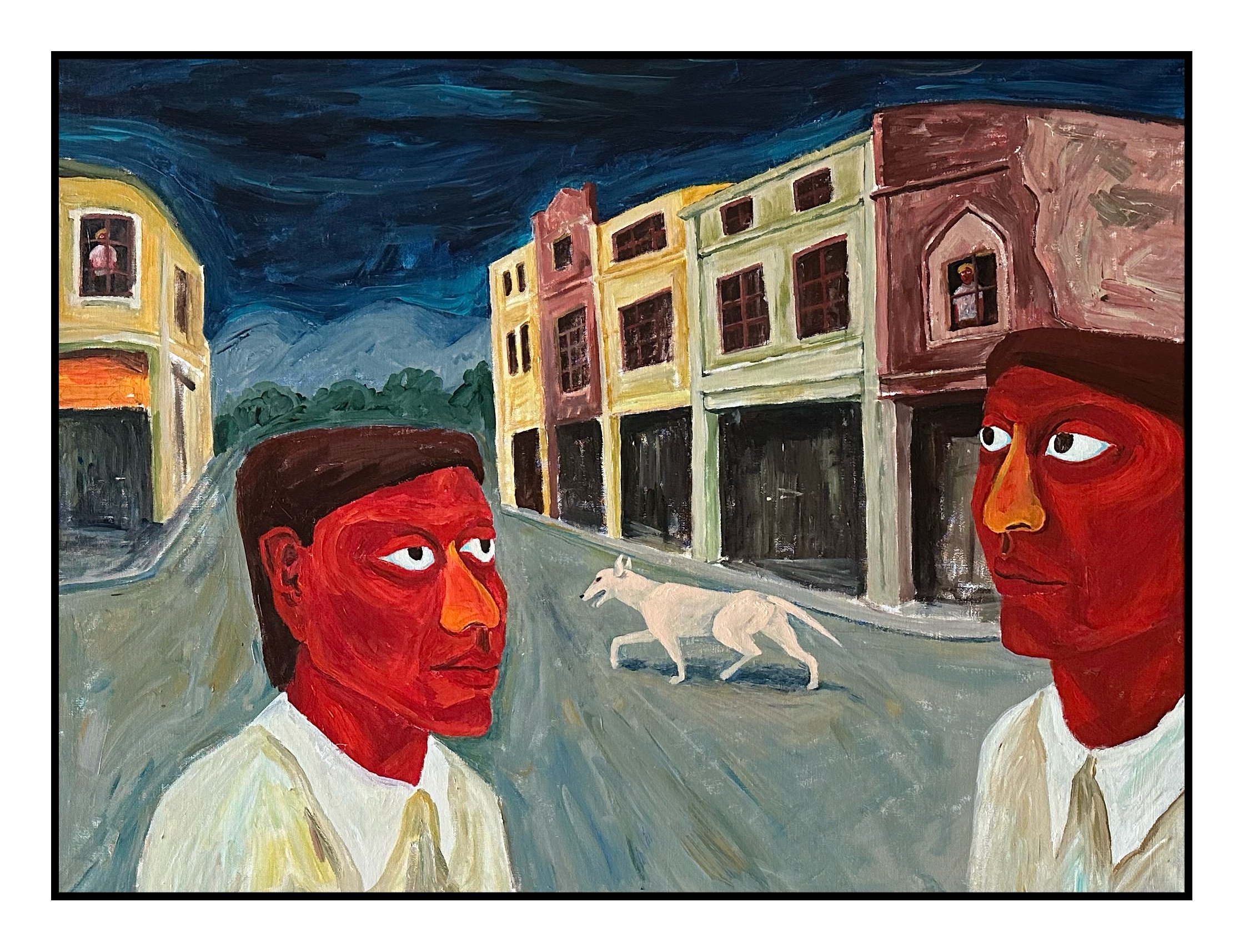Shuang Sun
The Enigmatic Worlds of Shuang Sun: An Exploration of Mystery, Psychology, and Symbolic Surrealism
Shuang Sun’s art presents a profoundly captivating exploration of human psychology, imbued with surreal, often ambiguous narratives that linger in the viewer’s mind long after the initial encounter. Her works convey a sense of mystery, not merely in subject but in form, color, and composition. Each painting operates within a framework of vibrant colors and oddly juxtaposed figures, evoking echoes of Marc Chagall’s dreamlike whimsy and the haunting stillness of Edward Hopper’s urban scenes. Yet, her style transcends direct comparison, possessing a unique balance between symbolic surrealism and raw, palpable emotion.
In examining her series, one cannot ignore the duality that underpins her work. Shuang Sun frequently places characters within familiar settings—a street, a rooftop, a room—but disrupts the ordinary with surreal elements: a figure cloaked in an unusual color, animals seemingly charged with symbolic weight, or forms that hover ambiguously between the real and the fantastical. This blend of ordinary and strange draws the viewer into a meditative space, encouraging them to delve beyond surface interpretations and into a realm of introspective possibility.
Consider her piece “Soul Hunter”. This work encapsulates Shuang Sun’s mastery over ambiance. A large, almost intimidating figure with greenish-yellow skin sits with an expression that can be read as melancholic or contemplative, their hand supporting a face etched with a peculiar sense of both resignation and anticipation. The presence of a black cat on a vibrant pink circle introduces a sense of mysticism, as if the cat were a familiar or an otherworldly agent bridging the gap between viewer and subject. The moonlit night, bare trees, and unnatural hues converge to cast the scene in a spectral light. There is something of the German Expressionists here, especially Ernst Ludwig Kirchner’s sense of distorted form and color used not merely as a visual choice but as an emotional amplifier. The green-tinged figure in the background appears almost ghostly, a witness or an echo of the central figure’s inner life, creating a dialogue that extends beyond the painted world into the viewer’s own contemplative space.
“On the Roof” invites comparison to the works of René Magritte in its unassuming, almost mundane portrayal of two figures seated side by side, yet the atmosphere is thick with unspoken tension. The figures’ starkly pink faces, marked by deep shadows, gaze at the viewer with expressions that are both direct and inscrutable. Shuang Sun creates a paradox of connection and disconnection; the two figures appear together yet profoundly isolated, each immersed in their private thoughts. This portrayal of shared solitude, underscored by the angular architecture in the background, mirrors the alienation often found in urban life, a theme Hopper also visited in works like Nighthawks. However, Shuang Sun’s figures seem aware of the viewer’s gaze, as if waiting to communicate something that words would only distort.
In her painting “At Dusk”, Shuang Sun brings a more overtly surreal approach, reminiscent of Giorgio de Chirico’s metaphysical cityscapes, yet injected with an emotional immediacy that feels unmistakably contemporary. Two figures, painted in red, confront each other in a deserted street under a swirling blue sky. A lone white dog wanders between them, enhancing the painting’s dreamlike, almost cinematic quality. The empty windows, muted architecture, and stark contrasts of color amplify a sense of quiet tension and unresolved narrative. Shuang Sun’s choice of color—bold reds against cool blues—serves not just to catch the eye but to evoke a visceral response. The viewer feels as though they have interrupted an intimate, cryptic exchange in an alienated world.
Shuang Sun’s technique of using color as a means of psychological insight continues in “Singing Under the Moon”, where two black swans are set against a swirling sea and sky under a luminous moon. The scene is charged with mythic undertones, with the black swans symbolizing mystery, transformation, and the unknown. The composition’s simplicity allows the intensity of the swans' dark forms and their sharp red beaks to dominate, creating a visceral visual impact. This image recalls Odilon Redon’s Symbolist works, where colors are less about naturalism and more about conveying spiritual or emotional intensity. The quiet, almost meditative quality of the swans’ forms contrasts with the dynamic, turbulent background, a visual duality that encourages contemplation of inner and outer worlds.
One of the more striking aspects of Shuang Sun’s work is her exploration of the relationship between humans and animals. This theme recurs throughout her oeuvre, whether in the presence of black cats, solitary birds, or wandering dogs. In “The Only Way”, the artist portrays a young man with a dog against a pastoral backdrop, with a lone white horse in the distance. The figures are static, almost statuesque, as if caught in a trance. Here, Shuang Sun’s dog seems to embody loyalty, companionship, or perhaps an alter ego of the human subject. There is a sense of symbiosis between the man and his animal companion, a connection that goes beyond simple domestication and hints at a deeper, almost spiritual bond. This portrayal brings to mind Franz Marc’s affinity for the animal world, wherein animals are not merely subjects but emblems of purity and essence. Shuang, however, nuances this bond with a contemporary edge, capturing an almost existential yearning in the human figure.
Her painting “Swallows Fly South” serves as a quieter, almost melancholic counterpoint to her more vivid pieces. Here, two blue-toned figures stare solemnly into the distance, while swallows soar above them, a boat drifting in the background. The color palette is restrained, dominated by blues and purples, lending the piece a subdued, meditative quality. The swallows suggest migration, transition, and passage, imbuing the work with themes of longing, departure, and perhaps nostalgia. There is a kinship here with the works of Marc Chagall, whose ethereal floating figures and animals often evoke the pull between home and distant lands, love and separation. Shuang Sun’s figures, however, remain grounded, yet their gaze into the distance implies a yearning for something beyond reach.
In “Mother and Child”, Shuang captures a tender yet enigmatic relationship. A woman, bathed in warm pinks and reds, stands protectively beside a yellow-skinned child, their eyes wide and expressionless, gazing into an undefined distance. The maternal warmth is evident, yet the scene is steeped in a curious ambiguity, as though the bond between mother and child transcends mere affection. The composition exudes both security and a faint undercurrent of anxiety, a dichotomy that lends it an almost mythical quality. It brings to mind the works of Gauguin, where maternal figures are revered but enshrined in a world of mystery and cultural symbolism. Shuang Sun’s figures, while stripped of specific cultural signifiers, embody a universal sentiment, a protective yet detached connection that invites viewers to consider the nature of familial ties.
In examining Shuang’s overall body of work, it becomes clear that her paintings are less about the physical world and more about the psychological landscapes within. Each piece functions as a visual poem, rich with symbols and imbued with an atmosphere of introspection. Her characters, caught in a liminal space between the ordinary and the surreal, seem to embody fragments of an internal narrative that Shuang leaves open to interpretation. Like the works of Balthus, Shuang Sun’s scenes invite a suspension of conventional logic and an embrace of the ambiguous. Her compositions feel both intimate and alien, filled with figures who are as much symbols as they are individuals, each a cipher for the viewer to interpret.
Shuang Sun is a rare voice in contemporary art, adept at creating worlds that are as visually captivating as they are emotionally resonant. Her works transcend simple representation, tapping into universal themes of alienation, longing, and introspection. She achieves a delicate balance between familiarity and otherness, blending dreamlike elements with sharp psychological insight. Shuang Sun’s use of color and form defies convention, establishing her as an artist who does not merely depict but delves into the soul's hidden recesses, urging viewers to embark on their own journey of self-discovery. In her world, every character, animal, and setting is charged with latent meaning, awaiting the viewer’s interpretation. Her paintings, with their mysterious allure, beckon us not just to look but to linger, to decipher, and ultimately, to find a piece of our own story within their enigmatic depths.
Soul hunter, 2024. Acrylic on canvas, 80x100cm.
Mother and child, 2024. acrylic on canvas, 60x80cm.
Kung Fu men, 2024. Acrylic on canvas, 60x80cm.
Skyland, 2024. Acrylic on canvas, 60x60cm
Swallows fly south, 2024. Acrylic on canvas, 60x60cm
The only way, 2024. Acrylic on canvas, 60x80cm
Fantasy shines in reality, 2024. Acrylic on canvas, 60x80cm
Singing under the moon, 2024. Acrylic on canvas, 60x80cm
At dusk, 2023. Acrylic on canvas, 80x60cm.
On the roof, 2024. Acrylic on canvas, 80x60cm












